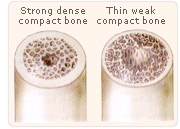
Osteoporosis is a growing problem among women in today's society. A result of weakening bone mass, osteoporosis occurs with age and can be one of symptoms of menopause. This study investigates what can be done to better inform women about this common early menopause symptom. It discusses the specific issue of osteoporotic fracture and how early intervention can help deal with this early symptom of menopause. It survey women undergoing all three stages of menopause and their experiences with regards to osteoporosis, a serious and debilitating disease and a common early menopause symptom.
Women undergoing menopause are particularly at risk of osteoporosis and this illness can be an early menopause symptom. Many health organizations feel that rates of osteoporotic fracture can be decreased by using current interventions to prevent, diagnose, and treat it. The National Osteoporosis Foundation (NOF) believes that physicians should advise women about the risk factors for osteoporosis, a widespread early menopause symptom. Furthermore, the US Preventive Services Task Force (USPSTF) recommends that all perimenopausal and postmenopausal women should discuss hormone replacement therapy with their physician as a form of prevention.
Those most likely to be affected by osteoporosis include women aged 65 years and over, all postmenopausal women younger than 65 years who have 1 or more additional risk factors for the disease, postmenopausal women with fractures, women considering therapy for osteoporosis as an early menopause symptom, and women who have undergone lengthened periods of hormone replacement therapy.

Participants of this survey were asked to note their early menopause symptoms including hot flashes, difficulty sleeping, and poor memory. Results showed that discussions about preventive measures for osteoporosis were lowest among premenopausal women, who are affected by early menopause symptoms. Discussions were more common among perimenopausal women but fairly infrequent among postmenopausal women, many of whom had undergone hormone replacement therapy.
Therefore, counseling for premenopausal and perimenopausal women about preventing osteoporosis can be significantly increased. Although it is a common early menopause symptom, age-related decrease in bone mass occurs before menopause and many premenopausal and perimenopausal women can have low bone mass. A sufficient intake of calcium and vitamin D can help to work against this before menopause and the early symptoms of menopause.
Generally, women are informed about osteoporosis during the postmenopausal stage or from age 50 years onward, during which time they may have undergone hormone replacement therapy. Though, osteoporosis is a familiar early menopause symptom and frequently associated with this period in a woman's life. This investigation indicates that greater intervention may improve the diagnosis and treatment rates of this illness, including the available treatments away from hormone replacement therapy.
It is evident that current osteoporosis-related practices can be greatly improved to try and combat this disease, a frequent early menopause symptom. Counseling for premenopausal and perimenopausal women needs to be improved most of all. Although a common early menopause symptom, osteoporosis occurs before menopause and women should be guided as to how they can help prevent this disease early on. More research is needed into this growing illness, an early menopause symptom.